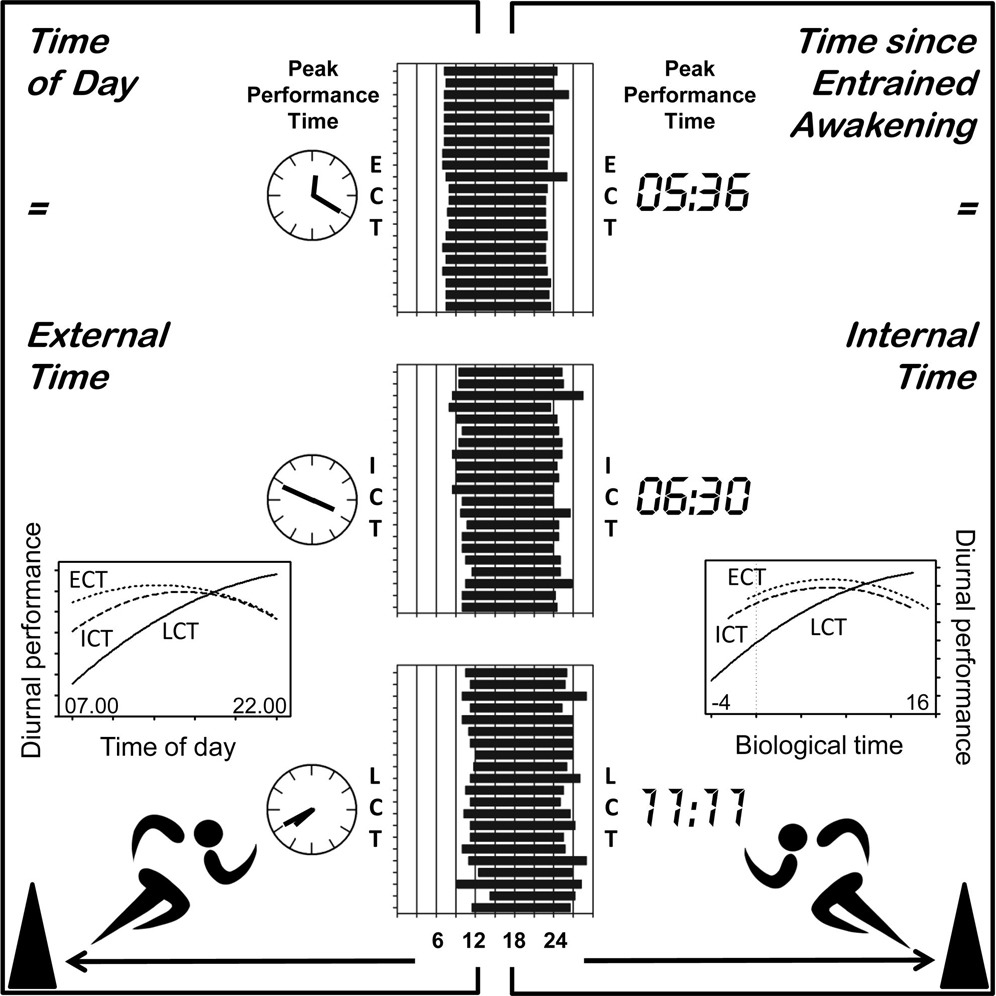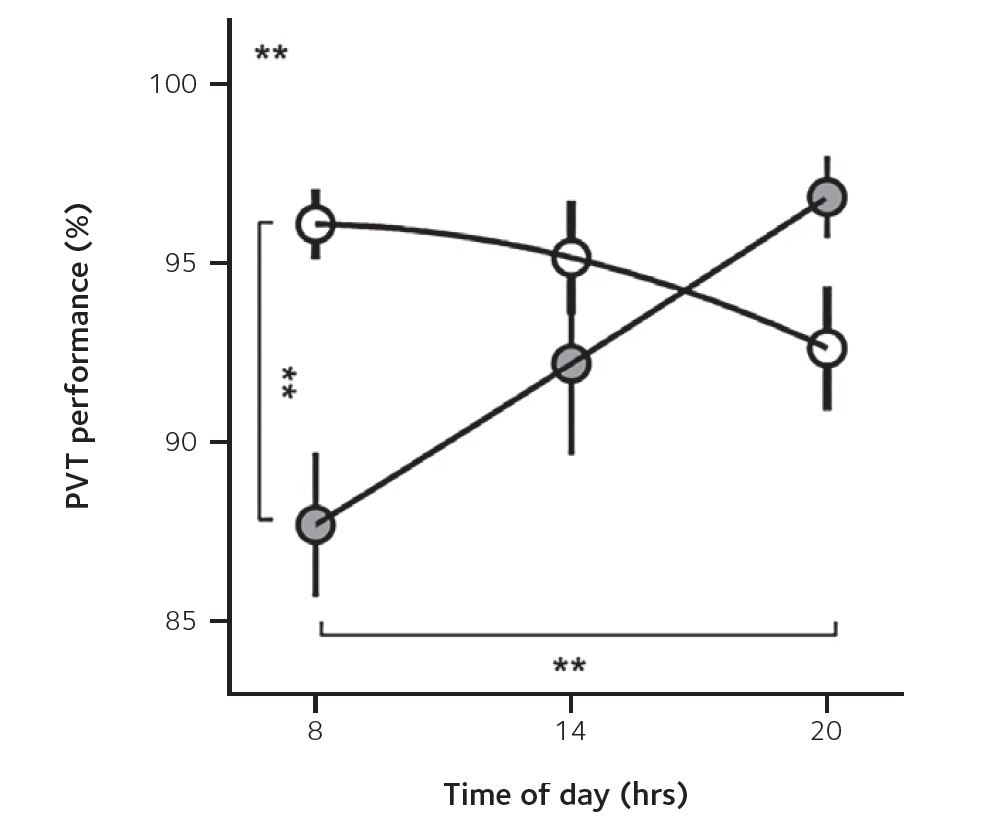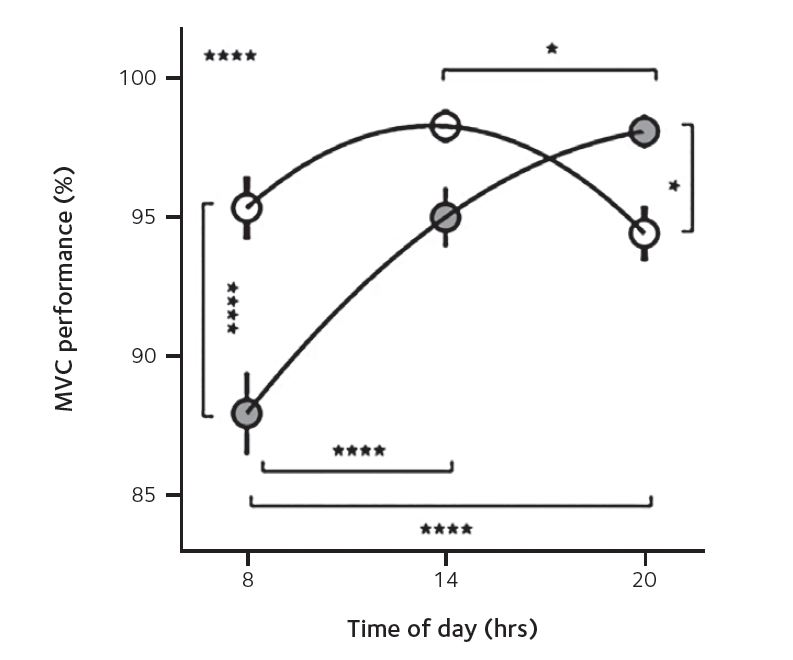
Physiology News Magazine
Time to win gold
Could chronobiology make the difference between winning and losing for elite athletes?
Features
Time to win gold
Could chronobiology make the difference between winning and losing for elite athletes?
Features
Luis Mascaro, Monash University, Australia
Elise R Facer-Childs, Monash University, Australia
https://doi.org/10.36866/pn.118.36
Timing is everything. It allows us to anticipate the best time to conserve energy, identify the time of peak performance, recognise when attention may be sub-optimal, and find the most effective time for nutritional intake. The study of timing and cyclic phenomena in humans is termed human chronobiology (chrono = time) and has many implications for the elite athlete.


Circadian timing and athletic performance
Circadian biology is a subset of chronobiology that involves the study of cyclic phenomena with a period of approximately 24 hours (circa dian = about a day). The circadian system, commonly referred to as our internal clock, is responsible for temporally organising our physiology across the 24-hour day. This includes setting the timing of gene expression in individual cells to regulate cellular metabolism and growth/repair, to coordinate the ~24-hour rhythmicity in cross-tissue processes such as hormone signalling and core body temperature. It is perhaps unsurprising then, that there is a daily rhythm in athletic performance.
Such internal timing has a bidirectional interaction with timing of behaviours such as when we eat, sleep, and work. Our physiology can affect our behavioural choices and our behavioural choices can determine the timing of exposures to which our circadian system aligns; the best studied example is the light–dark cycle. For many individuals, their diurnal (daily) timing of behaviours will be strikingly different on work days compared with free days such as weekends as a result of behavioural preferences. Other social commitments such as having to get up earlier to get kids ready for school could also affect the exposures to which the circadian system aligns and be at odds with behavioural preference.
Information on timing of actual behaviour, timing of behavioural preferences, and timing of circadian rhythms (for instance, whether they peak or trough earlier or later in the day), in whole or in part, can be used to classify individuals into different clock ‘types’. Being an early, intermediate or late type is known as your circadian phenotype (sometimes referred to as chronotype) (Facer-Childs et al., 2020). An early type will tend to rise earlier, perform at their best earlier, and go to sleep earlier. The opposite is true for a late type.
Clearly, given the multitude of physiological processes that are circadian regulated, the synchrony between our internal clock time, behavioural preferences, and actual timing of activities (external time), athletic performance can be affected. Not only will chronobiology affect the time of day of peak performance but also the ability to achieve maximum possible performance levels more generally.

This is very important for the elite athlete. Being able to manipulate peak timing of performance, for instance, could result in a significant competitive advantage. As an example, field data demonstrate a variation in performance (measured by cardiovascular endurance) of up to 26% depending on the time of day of tasks and an individual’s circadian phenotype (Facer-Childs and Brandstaetter, 2015a). To put this data into perspective, a change in performance by 0.5% in the 2016 Olympics 100 m freestyle swimming event was the difference between fourth place and a gold medal, and a 2.5% increase in performance would have secured a gold medal, over Usain Bolt, for the last-placed runner in the 100 m sprint. Thus, there are likely gains to be made in elite performance from implementing chronobiological strategies that could make significant differences to sporting outcomes. Indeed, athletes may want to avoid mismatches between internal clock timing and real-life behaviours.
Schedule, sleep, and strategies
Elite athletes frequently face rigorous training and competition schedules including early morning rises and physically intense sessions. They also cannot control when, and where, the competition will be. Often, training, matches, or events can continue into the early evening, making it hard to switch off and settle before bed. Many elite athletes have documented that they have trouble “switching off” at bedtime following important sporting events. For instance, Paul O’Connell (a former professional rugby player) writes in his autobiography about the stress following games that impaired his sleep. In addition, elite athletes have personal lives and other commitments that can interfere with their sleep–wake cycles. Importantly, sleep can significantly affect training responses, performance, and risk of injury. For instance, the improvement in performance characteristics by NBA basketball players such as Andre Iguodala associated with improved sleep is remarkable (Berger, 2016).

Thus, it is quite clear that there is a need for elite athletes and their coaching teams to harness whatever advantage they can regarding their timing of behaviour, so that their sleep–wake and other activity schedules can assist in preparing optimally for peak performance. Although most competition schedules are rigid, training schedules can be carefully planned and managed by the high-performance team. Therefore, with the correct research base and expertise, manipulating these schedules might represent an opportunity to help in achieving optimal chronobiology.
Before factoring in circadian timing, however, a number of sleep hygiene recommendations could be considered, to assist athletes in their daily routines. A sleep schedule that is consistent in timing, of an adequate duration (for that individual), and of good quality is essential. The sleeping environment should have as little noise or light in order to promote sleep quality. Next, bright light, especially electronic device blue light should be limited in the hours preceding bed. Caffeine intake and meal timings should be carefully monitored and based on individual needs (Halson, 2008). Of course, all of these recommendations should be carried out in consultation with expert advice.
Sleep hygiene practice is often achievable with enough motivation. However, the consideration of chronobiology and circadian phenotype into elite athlete populations is practically more difficult and is a focus for future research. It requires some knowledge of the athlete’s circadian rhythms and behaviours, which as previously discussed, can vary considerably between individuals and according to different schedules. Knowledge of circadian phenotype may be useful information but objective sleep monitoring for an adequate period as well as biological sampling is typically required in addition to continued one-on-one work with each individual. In the context of an under-pressure athlete, these factors may be viewed as burdensome; however, the benefits could outweigh the risk if performance was enhanced.
The elite athlete as a special-risk traveller
A tangible example of behaving discordant with your internal timing is the phenomenon of jet lag from international travel. If one travels from London, England, to Melbourne, Australia, one arrives in a time zone and light–dark cycle operating 11 hours ahead. That is, touching down in Melbourne at 10:00 PM, you may feel quite alert, because your body is still entrained (i.e. the circadian system is adapted) to the light–dark cycle of London and thinks it is 11:00 AM. Due to the nature of elite athlete competitions, transmeridian travel is often inevitable. The subsequent circadian desynchrony that can lead to impaired performance is one problem that must be managed.

Some athletes travel days in advance so that they have time to adapt to a new time zone. Others may try to remain on their “home” time if their “home” timing of peak performance coincides with competition time. For instance, Formula 1 drivers from Europe may choose to stay on “home” time for the Singapore Grand Prix as the race time (night) in Singapore is closer to peak performance time (mid-afternoon) in Europe (Straka, 2011). In this instance, not only could circadian awareness improve performance, but when racing at high speeds, it could be key to preventing split-second lapses of attention resulting in grave injury. Similarly, North American West Coast football teams travelling east have an advantage when it comes to Monday night start times as their peak performance times may coincide with game times and this manifests in winning percentages (Jehue et al., 1993). A significant disadvantage is presented to eastern teams who must travel west and more so for late start times because their “home” time could be after midnight (Roy and Forest, 2018).
Early and late types
It is important to note that one’s circadian phenotype is on a spectrum, with the extreme early types and extreme late types at either end (Facer-Childs et al., 2020). Although not everyone will be at either end, many people have a tendency towards one or the other. The composition of early and late types will vary slightly between populations and genders. For example, more females are early types and there are a higher proportion of late types amongst adolescents (Fischer et al., 2017). Individual differences will be seen in all populations, including educational settings, office-based jobs, safety-critical industries, the arts, and elite athletes. Yet, the reality is that most work–life schedules do not yet account for circadian phenotype.
We are all aware that feelings of alertness, productivity or sleepiness will vary throughout the day, but what is less commonly known is that these rhythms can differ significantly between early and late types. Research has shown that these groups have different diurnal rhythms in their mental performance, brain function, physical abilities and mood (Facer-Childs et al., 2018, Facer- Childs et al., 2019a).
Given the clear time-of-day variation in physiology, psychology and behaviour, schedules will seldom match these individual differences. Thus, in a typical day from 9:00 AM to 5:00 PM, students, workers and athletes will experience dips in performance and productivity that not only affect the individual, but can affect the team or people around them, all because they are forced to work at a time of day that their body does not agree with. For athletes, early morning training and rigid schedules may lead to the greater number of early types observed in some sports (Kunorozva et al., 2012). Potentially, late types who typically compete in morning events may not appreciate that they can achieve higher levels of performance were the events scheduled later in the day and vice versa. Anecdotally, world records are typically broken in the late evening time, possibly due to television broadcasting prime times). One wonders whether more world records would be broken if athletes could compete at the optimal timing of performance as might be predicted by their circadian phenotype.

Future perspectives and consultant chronobiology
An elite athlete will have some insight or feeling into daily variations of when they feel or perform their best. However, with research-based evidence and expert consultants, an athlete can consider interventions to shift the timing of their biological rhythms to try and optimise performance (Facer-Childs et al., 2019b). Research now demonstrates that there is a point in the day an athlete is likely to be achieving peak performance, based on circadian phenotype and time since entrained wake (Facer-Childs and Brandstaetter, 2015a). However, training and competition do not necessarily align with the athlete’s internal timing. Therefore, there is motivation for a multidisciplinary team to work in conjunction with the athlete to shift their circadian timing to match that of the desired competition timing. For example, an early type may, on average, reach their peak performance at around 1:00 PM. However, their sport of choice may tend to be played in the evening. This athlete might, therefore, be motivated to delay their circadian rhythm. Whereas, for a late type who needs to perform their best earlier in the day, a phase advance of their circadian rhythm would be required.
On the extreme side, regardless of circadian phenotype, an athlete may need to participate in an international competition that is based in a time zone with 9 hours difference. This athlete/coaching team would be mindful to prepare for weeks in advance and consider techniques to adapt in consultation with a chronobiologist.
Practising good sleep hygiene, and interventions regarding circadian timing, has an exciting potential to improve recovery and increase performance in elite athletes (Samuels, 2008). Furthermore, awareness of these factors may have even broader implications beyond the individual. For team-based sports, it is possible that a coaching team may consider individual differences when planning schedules to manage team alertness and performance accordingly (Facer-Childs and Brandstaetter, 2015b).
It is important that the current research into chronobiology and sport is not taken out of context at this stage. Yes, differences in the peak performance of elite athletes will differ between early and late types. Similarly, there are techniques that can assist sleep health and help individuals to better adapt to travel, training or competition demands. However, importantly, this research is still in its infancy relative to other sports medicine fields. These techniques and potential interventions require carefully monitored practices by educated professionals with expertise in sleep and chronobiology. Athletes often have on-call or full-time physiotherapists, nutritionists and psychologists to provide expert opinions to assist the athlete in their quest for performance gains and competition achievement. Perhaps in the future, with increasing research and awareness in sleep and biological rhythms, sporting organisations will start to consider chronobiology consultants as part of their normal routine in preparation for elite competition.
For now, we hope that elite athletes together with their coaching and management teams can begin to increase their awareness of how factors such as sleep health, circadian phenotype, and chronobiology impact recovery and performance. Even a 1% change in performance could deliver the much-sought-after competitive advantage and deliver the gold. After all, timing is everything.
References
Berger K (2016). In multi-billion-dollar business of NBA, sleep is the biggest debt. [Online] Available at: www.cbssports.com/nba/news/in-multi-billion-dollar-business-of-nba-sleep-is-the-biggest-debt/ [Accessed 2 March 2020]
Facer-Childs E and Brandstaetter R (2015a). The impact of circadian phenotype and time since awakening on diurnal performance in athletes. Current Biology 25, 518 – 522. DOI: 10.1016/j.cub.2014.12.036
Facer-Childs E and Brandstaetter R (2015b). Circadian phenotype composition is a major predictor of diurnal physical performance in teams. Front Neurol 6, 208. DOI: 10.3389/fneur.2015.00208
Facer-Childs, ER et al. (2018). The effects of time of day and chronotype on cognitive and physical performance in healthy volunteers. Sports Medicine Open 4(1), 1 – 12. DOI: 10.1186/s40798-018-0162-z
Facer-Childs ER et al. (2019a). Circadian phenotype impacts the brain’s resting-state functional connectivity, attentional performance, and sleepiness. Sleep 42, zsz033. DOI: 10.1093/sleep/zsz033
Facer-Childs ER et al. (2019b). Resetting the late timing of ‘night owls’ has a positive impact on mental health and performance. Sleep Medicine 60, 236 – 247. DOI: 10.1016/j.sleep.2019.05.001
Facer-Childs ER et al. (2020). Human Circadian Phenotyping and Diurnal Performance Testing in the Real World. Journal of Visualized Experiments (158) e60448. [Online] Available at: www.jove.com/video/60448/human-circadian-phenotyping-diurnal-performance-testing-real [Accessed 2 March 2020]
Fischer D et al. (2017). Chronotypes in the US–influence of age and sex. PloS one 12, e0178782. DOI: 10.1371/journal.pone.0178782
Halson SL (2008). Nutrition, sleep and recovery. European Journal of Sport Science 8, 119 – 126. DOI: 10.1080/17461390801954794
Jehue R et al. (1993). Effect of time zone and game time changes on team performance: National Football League. Medicine & Science Sports Exercise 25, 127 – 131. DOI: 10.1249/00005768-199301000-00017
Kunorozva L et al. (2012). Chronotype and PERIOD3 variable number tandem repeat polymorphism in individual sports athletes. Chronobiology International 29, 1004 – 1010. DOI: 0.3109/07420528.2012.719966
Roy J and Forest G (2018). Greater circadian disadvantage during evening games for the National Basketball Association (NBA), National Hockey League (NHL) and National Football League (NFL) teams travelling westward. Journal of Sleep Research 27, 86 – 89. DOI: 10.1111/jsr.12565
Samuels C (2008). Sleep, recovery, and performance: the new frontier in high-performance athletics. Neurologic Clinics 26, 169 – 180. DOI: 10.1016/j.ncl.2007.11.012
Straka (2011). [Europe in Singapore. Sebastien Vettel sleeps until 2pm] Europa in Singapur: Sebastian Vettel schläft bis 14 Uhr. Hamburger Abendblatt. [Online] Available at: www.abendblatt.de/sport/formel1/article108135474/Europa-in-Singapur-Sebastian-Vettel-schlaeft-bis-14-Uhr.html [Accessed 8 March 2020]
